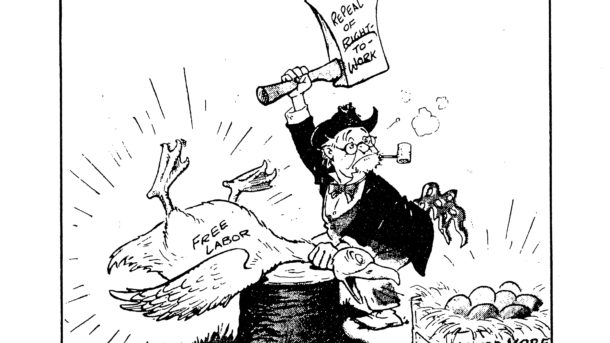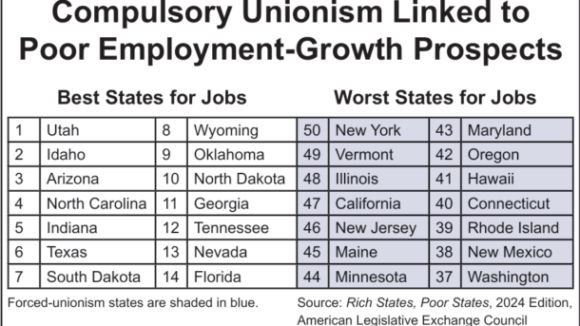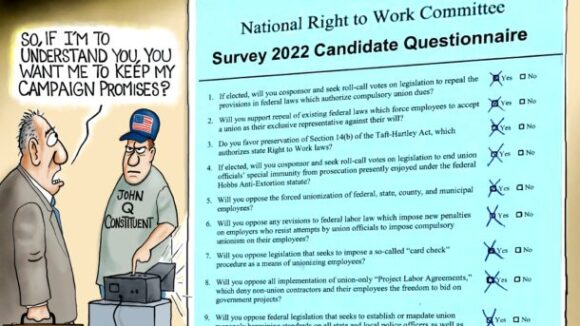Is This Any Way to Run a City’s Schools?
Leaked CTU Proposals Won’t Do Anything to Improve Schools’ Poor Performance

Forced-Dues State Households Have Less to Spend
Higher Costs For Consumers Translate Into Lower Living Standards
On paper, it seems like K-12 public school teachers are paid well in forced-unionism California. According to an analysis furnished to the media by National Education Association (NEA) union bosses, the average annual salary for a teacher in the Golden State is $77,000.
But the reality is that California K-12 educators recognize they don’t live so well relative to educators in other states.
That’s why teachers are fleeing Big Labor-controlled California in droves.
This May, the Sacramento Bee reported that, from 2003 to 2016, “about 18,000 more elementary and secondary school teachers left California than came from other states.”
Teachers Obviously Understand What Union Spokesmen Choose to Overlook
California’s largest net loss to any state, totaling roughly 6,000 teachers, was to Right to Work Texas. Yet NEA union propagandists claim teacher pay is substantially lower in Texas than it is in California!
Teachers obviously understand what union spokesmen choose to overlook:
The standard of living for any employee, including a teacher, depends on his or her living costs and tax burden, as well as nominal pay.
That’s why living standards in Texas and Right to Work states generally are higher than they are in California and forced-unionism states generally.
Economists and ordinary Americans recognize that the purchasing power of the U.S. dollar varies widely from state to state, but many people may assume there is no reliable way to incorporate cost-of-living disparities into income and earnings data.
Fortunately, for many years now, employees considering relocation to another state and companies seeking to hire capable employees from out of state have been able to consult interstate cost-of-living indices that are calculated and published by the Missouri Economic Research and Information Center (MERIC).
In 2017, Not One of the 14 Most Costly States to Live In Had a Right to Work Law
Based in Jefferson City, Mo., MERIC is a state government agency with no ax to grind on the Right to Work issue.
And its web site reports that MERIC has been “recognized with 15 national awards for research excellence since it was formed in 2001.”
MERIC’s indices factor in housing, food, utilities, transportation, health care and other miscellaneous goods and services.
For roughly a decade and a half, the National Institute for Labor Relations Research has used MERIC’s indices to make apples-to-apples comparisons of wages, salaries, and other forms of income in Right to Work and forced-unionism states.
MERIC’s annual data for 2017 show that, among the 14 states with the highest overall cost of living last year, not one has on the books and in effect a Right to Work law barring the termination of employees for refusal to join or pay dues or fees to an unwanted union.
But all of the seven lowest-cost states, and 16 of the 18 lowest-cost states, were and are Right to Work.
Along with housing, food, and utility costs, overall tax burdens are substantially lower in Right to Work states than they are in forced-unionism states.
In 2017 specifically, according to the nonpartisan, Washington, D.C.-based Tax Foundation, residents of forced-unionism states forked over 33.2% of their total personal income in federal, state and local taxes, a 13% higher share than the Right to Work state average.
Right to Work State Residents Receive Two Extra Weeks of Take-Home Pay
“Tax Freedom Day” (TFD), the day when, as the Tax Foundation has explained, all Americans or the residents of a particular state or group of states have “earned enough money to pay” their “total tax burden for the year,” didn’t arrive until May 1 in forced-unionism states as a group in 2017.
In contrast, TFD 2017 in Right to Work states as a group came on April 17, a full two weeks earlier than the forced-unionism average.
When 2017 state average (mean) household income data, as reported on the U.S. Census Bureau’s American FactFinder web site, are adjusted for differences in living costs and tax burdens, the results show that four of the five highest-ranking states have Right to Work laws.
Meanwhile, nine of the 10 bottom-ranking states lack Right to Work laws.

Forced Unionism-Fueled Class Warfare Doesn’t Foster Prosperity
Overall, according to the National Institute for Labor Relations Research’s analysis, the average cost of living-adjusted, after-tax income per household in Right to Work states last year was $57,416, roughly $4,500 higher than the forced-unionism state average.
National Right to Work Committee President Mark Mix said that no one ought to be surprised by the Institute’s findings.
“The forced-union-dues system foments hate-the-boss class warfare in many workplaces,” he noted.
“It helps Big Labor impose and perpetuate counterproductive and costly work rules. And union bosses funnel a large share of the forced dues and fees they collect through this system into the campaigns of Tax & Spend, regulation-happy state and local politicians.
“Undoubtedly, this is an important reason why ‘Tax Freedom Day’ consistently arrives roughly two weeks earlier, on average, in Right to Work states than in forced-unionism states.”
Mr. Mix concluded that it is only logical that, in states where forced union dues and fees are still permitted, workers and other residents would end up with less real purchasing power.
“Cost of living-adjusted, after-tax federal data confirm that’s exactly what happens,” he added.
Big Labor Propagandists Ignore Cost of Living’s Impact
But many statistics regarding incomes in Right to Work and forced-unionism states cited by Big Labor propagandists ignore regional cost-of-living differences completely.
For example, even though the Census Bureau has since 2011 regularly calculated and published data measuring poverty adjusted for differences in housing costs, Big Labor and its allies never reference these data, which show poverty is lower in Right to Work states than in forced-unionism states.
Instead, forced-unionism apologists simply ignore the relevant data and claim, in essence, we would all be better off if union officials could just force everyone to pay union dues or fees to get or keep a job.
“Union bosses and their allies in pro-Big Labor ‘think tanks’ understand that, if they adequately accounted for differences in living costs and taxes, their data would show living standards are higher in Right to Work states,’ said Mr. Mix.
“No wonder analyses comparing wages in Right to Work states and forced-unionism states published by the Big Labor-founded Economic Policy Institute routinely ‘under-compensate for the effect of living costs on wages,’ as a 2015 Heritage Foundation paper demonstrated.”
Big Labor Politicians Want Captive Employees, Firms To Have Nowhere to Flee
Unfortunately, if legislation now pending in both chambers of Congress and already sponsored by a total of 123 U.S. representatives and senators becomes law, employees whose freedom is curtailed and who are economically harmed by compulsory unionism will not be able to escape to a Right to Work state.
“H.R.5728/S.2810 and H.R.6080/S.3064, respectively cynically mislabeled as the ‘Workplace Democracy Act’ and the ‘Workers’ Freedom to Negotiate Act’ would both eliminate Right to Work protections for all private-sector employees and promote monopolistic unionism in a host of other ways,” said Mr. Mix.
“And if forced-unionism proponents make substantial gains in this fall’s elections, these anti-worker measures can be expected to be on the congressional agenda in 2019.”
(source: November-December 2018 National Right to Work Newsletter)

Leaked CTU Proposals Won’t Do Anything to Improve Schools’ Poor Performance

Wherever Big Labor wields the power to collect forced union dues, union bosses funnel a large share of the confiscated money into efforts to elect and reelect business-bashing politicians. Employment growth tends to lag as a consequence.

Members Insist They Keep Pro-Right to Work Campaign Promises